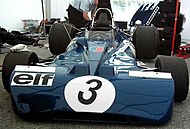Tyrrell 003
This article includes a list of general references, but it lacks sufficient corresponding inline citations. (February 2019) |
 Tyrrell 003 | |||||||||
| Category | Formula One | ||||||||
|---|---|---|---|---|---|---|---|---|---|
| Constructor | Tyrrell Racing Organisation | ||||||||
| Designer(s) | Derek Gardner | ||||||||
| Predecessor | 002 | ||||||||
| Successor | 004 | ||||||||
| Technical specifications | |||||||||
| Chassis | Aluminium monocoque | ||||||||
| Suspension (front) | Double wishbones, coil springs | ||||||||
| Suspension (rear) | Double wishbones, coil springs | ||||||||
| Engine | Ford-Cosworth DFV, 2,993 cc (182.6 cu in), 90° V8, Naturally aspirated, mid-mounted, | ||||||||
| Transmission | Hewland FG400 5-speed manual | ||||||||
| Fuel | Elf | ||||||||
| Tyres | Goodyear | ||||||||
| Competition history | |||||||||
| Notable entrants | Elf Team Tyrrell | ||||||||
| Notable drivers | |||||||||
| Debut | 1971 Spanish Grand Prix | ||||||||
| |||||||||
| Constructors' Championships | 1 (1971) | ||||||||
| Drivers' Championships | 1 (1971) | ||||||||
| n.b. Unless otherwise stated, all data refer to Formula One World Championship Grands Prix only. | |||||||||
The Tyrrell 003 is a Formula One (F1) racing car which was designed by Tyrrell's Chief Designer, Derek Gardner and used in the 1971 and 1972 F1 seasons. It was effectively the same car as the Tyrrell 001, with a redesigned nose section, longer wheelbase and narrower monocoque. Tyrrell 003 was a one-off design, its type number also serving as its Tyrrell chassis number. François Cevert drove the Tyrrell 002.
Conception
When Ken Tyrrell, the team's owner, became disenchanted with the poor performance of the March chassis during the 1970 season, he decided he would design and build his own car. He employed Derek Gardner to design it in secret at his own house.[1] The project, codenamed "SP", which meant "Special Project", cost Tyrrell over £22,000 of his own money. The resulting car named Tyrrell 001 made its debut at Oulton Park in a non-championship race.
After the season had finished, Gardner redesigned some sections of the car, altering the airbox, remodelling the nose section, lengthening the wheelbase and slightly narrowing the monocoque. The redesigned car became known as the 002 and 003, which were chassis numbers given to each of the cars made for the 1971 season. The team also switched tyre supplier to Goodyear after Dunlop withdrew from F1.
Competition
Driven by Jackie Stewart, it debuted at the 1971 Spanish Grand Prix and won at the first attempt. Tyrrell and Stewart took advantage as Lotus and Ferrari struggled during 1971; they won six races with Stewart claiming his second World Championship. Stewart and team mate François Cevert used different chassis throughout both 1971 and 1972, with Stewart having exclusive use of 003 and Cevert competing with the Tyrrell 002.
The 1972 season saw Lotus back in form with Emerson Fittipaldi challenging Stewart for the championship. The Tyrrell 003 was not a match for the developed Lotus 72 and the Tyrrell team only won when the 72 failed to finish. Fittipaldi won the title that season by a comfortable margin. Despite scoring two wins with Stewart during 1972 (he also won two races with the new 005), the 003 had come to the end of its racing life. Tyrrell 003 remains the Tyrrell team's most successful chassis.
The vehicle is currently on display at the National Museum of Scotland, Edinburgh.
The Tyrrell 003 was replaced by 005 for 1973.
-
Jackie Stewart driving the 003 at the 1972 French Grand Prix
-
The Tyrrell 003 at Canada in 2004
-
Tyrrell 003
Complete Formula One World Championship results
(key)(results in bold indicate pole position, results in italics indicate fastest lap)
| Year | Entrant | Driver | 1 | 2 | 3 | 4 | 5 | 6 | 7 | 8 | 9 | 10 | 11 | 12 | Points | WCC |
|---|---|---|---|---|---|---|---|---|---|---|---|---|---|---|---|---|
| 1971 | Elf Team Tyrrell | RSA | ESP | MON | NED | FRA | GBR | GER | AUT | ITA | CAN | USA | 73† | 1st | ||
| 1 | 1 | 11 | 1 | 1 | 1 | Ret | Ret | 1 | 5 | |||||||
| 1972 | Elf Team Tyrrell | ARG | RSA | ESP | MON | BEL | FRA | GBR | GER | AUT | ITA | CAN | USA | 51‡ | 2nd | |
| 1 | Ret | Ret | 1 | 2 | 11 | |||||||||||
Source:[2]
| ||||||||||||||||
† 54 points were scored using the Tyrrell 003; the other 19 points were scored using the Tyrrell 001 and Tyrrell 002
‡ 24 points were scored using the Tyrrell 003; the other 27 points were scored using the Tyrrell 002, Tyrrell 004 and Tyrrell 005
References
- Footnotes
- ^ Widdows, Rob (September 2008). "The Best Kept Secrets". Motor Sport magazine archive. p. 73. Retrieved 30 August 2015.
- ^ Small, Steve (1994). The Guinness Complete Grand Prix Who's Who. Guinness. p. 361. ISBN 0851127029.
- Sources
- Formula 1 official website-1971 Tyrrell team statistics
- Formula 1 official website-1972 Tyrrell team statistics
- Stewart, Jackie (2007). Winning Is Not Enough: The Autobiography. Headline. pp. 231–254 (chapter 10). ISBN 978-0-7553-1537-6.



